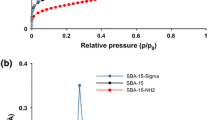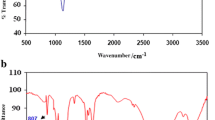Abstract
Four silica materials was prepared by using different synthesis procedures, with the goal of obtaining matrices with different designed textures, microporous, mesoporous, and ordered pore structured materials, as MCM-41 and SBA-15. These silica materials were used to prepare bare carbon paste electrode, without addition of other components, as nanostructured or electroactive species. In this way, it was possible to study the influence of the textural characteristics, such as surface area, pore volume, pore size, and pore shape on the electrode performance, in a detailed and individual form. The electrodes were studied by using [Fe(CN)6]3−/4− and sulfamethoxazole as probes, in diffusional processes, employing cyclic voltammetry and differential pulse voltammetry. It was observed that surface area and pore volume contribute expressively to the electroactive area. The worst results were attained for microporous materials (0.34 cm2), while the higher electroactive area values were obtained for materials with ordered pore structure, 2.01 cm2 for MCM-41 and 2.58 cm2 for SBA-15, by using [Fe(CN)6]3−/4− as probe. Regarding sulfamethoxazole as probe, the MCM-41 modified carbon paste electrode presented the best performance. The obtained sensitivity was 24.34 nA L μmol−1 and the detection limit found was 3.10 μmol L−1. These results are satisfactory considering the electrodes are constituted just by bare silica, easy to prepare, without addition of other components.








Similar content being viewed by others
References
Walcarius A (2018) Silica-based electrochemical sensors and biosensors: recent trends. Curr Opin Electrochem 10:88–97
Dai Z, Ju H (2012) Bioanalysis based on nanoporous materials. Trends Anal Chem 39:149–161
Yan F, Lin X, Su B (2016) Vertically ordered silica mesochannel films: electrochemistry and analytical applications. Analyst 141:3482–3495
Melde BJ, Johnson BJ, Charles PT (2008) Mesoporous silicate materials in sensing. Sensors 8:5202–5228
Onizhuk MO, Tkachenko OS, Panteleimonov AV, Varchenko VV, Belikov K, Kholin YV (2018) Electrochemical oxidation of quercetin in aqueous and ethanol-water media with the use of graphite/chemically modified silica ceramic electrode. Ionics 24:1755–1764
Ramos JVH, Morawski FM, Costa TMH, Dias SLP, Benvenutti EV, de Menezes EW, Arenas LT (2015) Mesoporous chitosan/silica hybrid material applied for development of electrochemical sensor for paracetamol in presence of dopamine. Microporous Mesoporous Mater 217:109–118
Montenegro LMP, de Souza LV, Lima KO, de Oliveira HPM, Fernandes AU, Morawski FM, Benvenutti EV, Arenas LT, Bianchini D (2018) Copper porphyrin immobilized on MCM-41 surface by using aminopropyl as coupling agent and its use in electrochemical oxygen determination. J Inorg Organomet Polym 28:2518–2524
Walcarius A (2013) Mesoporous materials and electrochemistry. Chem Soc Rev 42:4098–4140
Sing KSW, Everett DH, Hau RAW, Moscou L, Pierotti RA, Rouquerol J, Siemieniewska T (1985) Reporting physisorption data for gas/solid systems with special reference to the determination of surface area and porosity. Pure Appl Chem 57:603–619
Walcarius A (2001) Electroanalysis with pure, chemically modified, and sol-gel-derived silica-based materials. Electroanalysis 13:701–718
El-Nahhal IM, El-Ashgar NM (2007) A review on polysiloxane-immobilized ligand systems: synthesis, characterization and applications. J Organomet Chem 692:2861–2886s
de Menezes EW, Nunes MR, Arenas LT, Dias SLP, Garcia ITS, Gushikem Y, Costa TMH, Benvenutti EV (2012) Gold nanoparticle/charged silsesquioxane films immobilized onto Al/SiO2 surface applied on the electrooxidation of nitrite. J Solid State Electrochem 16:3703–3713
Caldas EM, Novatzky D, Deon M, de Menezes EW, Hertz PF, Costa TMH, Arenas LT, Benvenutti EV (2017) Pore size effect in the amount of immobilized enzyme for manufacturing carbon ceramic biosensor. Microporous Mesoporous Mater 247:95–102
Walcarius A, Mandler D, Cox JA, Collinson M, Lev O (2005) Exciting new directions in the intersection of functionalized sol–gel materials with electrochemistry. J Mater Chem 15:3663–3689
Módolo ML, Valandro SR, Pessoa CA, Fujiwara ST (2013) Carbon ceramic electrodes obtained by basic catalysis of sol–gel process. Electrochim Acta 112:783–790
Morawski FM, Deon M, Nicolodi S, de Menezes EW, Costa TMH, Dias SLD, Benvenutti EV, Arenas LT (2018) Magnetic silica/titania xerogel applied as electrochemical biosensor for catechol and catecholamines. Electrochim Acta 264:319–328
Didó CA, Caneppele CDG, Schneid AC, Pereira MB, Costa TMH, Benvenutti EV (2018) Small gold nanoparticles with narrow size distribution achieved in SBA-15 pores by using ionic silsesquioxane instead of thiol group as stabilizer and adhesion agent. Microporous Mesoporous Mater 270:48–56
Rao H, Wang X, Du X, Xue Z (2013) Mini review: electroanalytical sensors of mesoporous silica materials. Anal Lett 46:2789–2812
Walcarius A (2015) Mesoporous materials-based electrochemical sensors. Electroanalysis 27:1303–1340
Sanghavi BJ, Hirsch G, Karna SP, Srivastava AK (2012) Potentiometric stripping analysis of methyl and ethyl parathion employing carbon nanoparticles and halloysite nanoclay modified carbon paste electrode. Anal Chim Acta 735:37–45
Côme YBS, Lalo H, Wang Z, Kohring G-W, Hempelmann R, Etienne M, Walcarius A, Kuhn A (2013) Interest of the sol-gel approach for multiscale tailoring of porous bioelectrode surfaces. Electroanalysis 25:621–629
Deon M, Caldas EM, Rosa DS, de Menezes EW, Dias SLP, Pereira MB, Costa TMH, Arenas LT, Benvenutti EV (2015) Mesoporous silica xerogel modified with bridged ionic silsesquioxane used to immobilize copper tetrasulfonated phthalocyanine applied to electrochemical determination of dopamine. J Solid State Electrochem 19:2095–2105
Ganesan V, Walcarius A (2008) Ion exchange and ion exchange voltammetry with functionalized mesoporous silica materials. Mater Sci Eng B 149:123–132
Walcarius A, Delacote C, Sayen S (2004) Electrochemical probing of mass transfer rates in mesoporous silica-based organic–inorganic hybrids. Electrochim Acta 49:3775–3783
Xie X, Zhou D, Zheng X, Huang W, Wu K (2009) Electrochemical sensing of rutin using an MCM-41 modified electrode. Anal Lett 42:678–688
da Silva DN, Tarley CRT, Pereira AC (2017) Development of a sensor based on modified carbon paste with com iron (iii) protoporphyrin immobilized on sinbzn silica matrix for l-tryptophan determination. Electroanalysis 29:2793–2802
Sánchez A, Morante-Zarcero S, Pérez-Quintanilla D, del Hierro I, Sierra I (2013) A comparative study on carbon paste electrodes modified with hybrid mesoporous materials for voltammetric analysis of lead (II). J Electroanal Chem 689:76–82
Wang J, Walcarius A (1996) Zeolite containing oxidase-based carbon paste biosensors. J Electroanal Chem 404:237–242
Walcarius A, Rozanska S, Bessièrea J, Wang J (1999) Screen-printed zeolite-modified carbon electrodes. Analyst 124:1185–1190
Zhao Y, Yuan F, Quan X, Yu H, Chen S, Zhao H, Liu Z, Hilal N (2015) An electrochemical sensor for selective determination of sulfamethoxazole in surface water using a molecularly imprinted polymer modified BDD electrode. Anal Methods 7:2693–2698
Zhao D, Feng J, Huo Q, Melosh N, Fredrickson GH, Chmelka BF, Stucky GD (1998) Generalized syntheses of large-pore mesoporous metal oxides with semicrystalline frameworks. Science 279:548–552
Kresge CT, Leonowicz ME, Roth WJ, Vartuli JC, Beck JS (1992) Ordered mesoporous molecular sieves synthesized by a liquid-crystal template mechanism. Nature 359:710–712
Webb PA, Orr C, Camp RW, Olivier JP, Yunes YS (1997) Analytical methods in fine particle technology. Micromeritics Instrument Corporation, Norcross
Han J, Zhao J, Li Z, Zhang H, Yan Y, Cao D, Wang G (2018) Nanoporous carbon derived from dandelion pappus as an enhanced electrode material with low cost for amperometric detection of tryptophan. J Electroanal Chem 818:149–156
Bard AJ, Faulkner LR (2001) Electrochemical methods fundamentals and applications, 2nd edn. Wiley, New York
Grando SR, Benvenutti EV, Campo LF, Costa TMH (2016) Fluorescent mesoporous organosilicas containing 1,4-diureyl terephthalate moieties. J Photochem Photobiol A 325:22–28
Huang L, Kawi S, Hidajat K, Ng SC (2005) Preparation of M41S family mesoporous silica thin films on porous oxides. Microporous Mesoporous Mater 82:87–97
Walcarius A (2010) Template-directed porous electrodes in electroanalysis. Anal Bioanal Chem 396:261–272
Weng C-J, Hsu P-H, Hsu S-C, Chang C-H, Hung W-I, Wu P-S, Yeh J-M (2013) Synthesis of electroactive mesoporous gold–organosilica nanocomposite materials via a sol–gel process with non-surfactant templates and the electroanalysis of ascorbic acid. J Mater Chem B 1:4983–4991
Semaan FS, Pinto EM, Cavalheiro ETG, Christopher MA, Brett CMA (2008) A graphite-polyurethane composite electrode for the analysis of furosemide. Electroanalysis 20:2287–2293
del Torno-de Román L, Alonso-Lomillo MA, Domínguez-Renedo O, Arcos-Martínez MJ (2016) Tyrosinase based biosensor for the electrochemical determination of sulfamethoxazole. Sensors Actuators B Chem 227:48–53
Andrade LS, Rocha-Filho RC, Cass QB, Fatibello-Filho O (2009) Simultaneous differential pulse voltammetric determination of sulfamethoxazole and trimethoprim on a boron-doped diamond electrode. Electroanalysis 21:1475–1480
Calaça GN, Pessoa CA, Wohnrath K, Nagata N (2014) Simultaneous determination of sulfamethoxazole and trimethoprim in pharmaceutical formulations by square wave voltammetry. Int J Pharm Pharm Sci 6:438–442
Issac S, Kumar KG (2009) Voltammetric determination of sulfamethoxazole at a multiwalled carbon nanotube modified glassy carbon sensor and its application studies. Drug Test Anal 1:350–354
Arvand M, Ansari R, Heydari L (2011) Electrocatalytic oxidation and differential pulse voltammetric determination of sulfamethoxazole using carbon nanotube paste electrode. Mater Sci Eng C 31:1819–1825
Msagati TAM, Ngila JC (2002) Voltammetric detection of sulfonamides at a poly (3-methylthiophene) electrode. Talanta 58:605–610
Joseph R, Kumar KG (2010) Differential pulse voltammetric determination and catalytic oxidation of sulfamethoxazole using [5,10,15,20- tetrakis (3-methoxy-4-hydroxy phenyl) porphyrinato] Cu (II) modified carbon paste sensor. Drug Test Anal 2:278–283
Andrade LS, Rocha-Filho RC, Cass QB, Fatibello-Filho O (2010) A novel multicommutation stopped-flow system for the simultaneous determination of sulfamethoxazole and trimethoprim by differential pulse voltammetry on a boron-doped diamond electrode. Anal Methods 2:402–407
Souza CD, Braga OC, Vieira IC, Spinelli A (2008) Electroanalytical determination of sulfadiazine and sulfamethoxazole in pharmaceuticals using a boron-doped diamond electrode. Sensors Actuators B Chem 135:66–73
Cesarino I, Cesarino V, Lanza MRV (2013) Carbon nanotubes modified with antimony nanoparticles in a paraffin composite electrode: simultaneous determination of sulfamethoxazole and trimethoprim. Sensors Actuators B Chem 188:1293–1299
Acknowledgments
The authors thank CNPq (Conselho Nacional de Desenvolvimento Científico e Tecnológico), FAPERGS (Fundação de Amparo à Pesquisa do Estado do Rio Grande do Sul), and CAPES (Coordenação de Aperfeiçoamento Pessoal de Nível Superior) for financial support and grants. The authors also thank CNANO (Centro de Nanociência e Nanotecnologia) and CMM (Centro de Microscopia e Microanálise) of UFRGS (Universidade Federal do Rio Grande do Sul).
Author information
Authors and Affiliations
Corresponding author
Additional information
Publisher’s note
Springer Nature remains neutral with regard to jurisdictional claims in published maps and institutional affiliations.
Electronic supplementary material
ESM 1
(DOC 195 kb)
Rights and permissions
About this article
Cite this article
de Souza, L.V., da Rosa, D.S., Tkachenko, O.S. et al. The role silica pore structure plays in the performance of modified carbon paste electrodes. Ionics 25, 3259–3268 (2019). https://doi.org/10.1007/s11581-019-02882-0
Received:
Revised:
Accepted:
Published:
Issue Date:
DOI: https://doi.org/10.1007/s11581-019-02882-0




